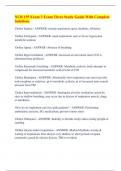NUR 155 Exam 3 Exam Three Study Guide With Complete
Solutions
Define Eupnea - ANSWER -normal respirations quiet, rhythmic, effortless
Define Tachypnea - ANSWER -rapid respirations seen w/ fever, hypoxemia,
metabolic acidosis
Define Apnea - ANSWER -Absence of breathing
Define Hyperventilation - ANSWER -Increased air movement more CO2 is
eliminated than produced
Define Kussmaul's breathing - ANSWER -Metabolic acidosis, body attempts to
compensate for increased metabolic acid in form of CO2
Define Bradypnea - ANSWER -Abnormally slow respiratory rate seen in pt who
took morphine or sedatives, pt w/ metabolic acidosis, pt w/ increased inter-cranial
pressure from TBI
Define hypoventilation - ANSWER -Inadequate alveolar ventilation caused by
slow or shallow breathing, may occur due to disease of respiratory muscle, drugs
or anesthesia
How do we implement care for cardia patients? - ANSWER -Positioning,
ambulation, exercise, I/O, medications, prevent venous stasis
Define Orthopnea - ANSWER -Inability to breathe easily unless sitting upright or
standing
Define cheyne stokes respirations - ANSWER -Marked rhythmic waxing &
waning of respirations from deep to very shallow w/ short periods of apnea
commonly caused by chronic disease, TBI or overdose
, What is the risk assessment tool for skin impairment? - ANSWER -Braden Scale
for predicting pressure sore risk
Pressure area risk assessment form scale
Define non-modifiable risk factos - ANSWER -Cannot be reduced; heredity, age,
gender
What do we do for patients in respiratory distress? - ANSWER -Assess,
administer meds(inhalers), monitor vitals, place in high flowers, place O2 on
patient, call provider
Define modifiable risk factors - ANSWER -Can be reduced; smoking, diabetes,
obesity, elevated serum lipids, hypertension, sedentary lifestyle
Describe mustache reservoir cannula - ANSWER -looks like mustache, O2
conserving, delivers 100% O2 bolus
Labs that are altered during acute problems - ANSWER -Troponin, CMP,
hemoglobin, Creatine Kinase (CK)
Describe the non-rebreather mask - ANSWER -Delivers highest O2 concentration
possible, 95-100% delivers 10-15 L/min
Implementing of promoting oxygenation - ANSWER -Position high fowlers, deep
breathing exercise, use O2 incentive spirometer, ambulation, percussion, clear
secretions
S/S of decreased oxygen - ANSWER -rapid pulse, rapid or shallow respirations
and dyspnea, increased restlessness, light headedness, flaring nostrils, intercostal
retractions cyanosis, irritability
What effect does ROM have on the respiratory system? - ANSWER -Strengthens
lungs
, Define dyspnea - ANSWER -Difficulty breathing or feeling of being short of
breath, flared nostrils, labored breathing, cyanosis, increased heart rate
Describe chronic confusion - ANSWER -Dementia
Never try to reorient
we step into their world
What is sensory overload? - ANSWER -Too much stimuli, EX: ICU patients,
anxiety and other issues can occur
Describe Acute confusion - ANSWER -From TBI or illness
Always try to reorient to reality
Describe Venous insufficiency - ANSWER -Swelling of legs & ankles, leg cramps,
shallow wounds, varicose veins, normal pedal pulses, increase edema, normal skin
temp., skin dry & flaky, pain is mild to moderate, elevation lessens pain
Describe the face tent mask - ANSWER -Used when a standard type mask is not
tolerated well by patient varying O2 concentrations; Delivers 4-8 L/min
Describe the venture mask - ANSWER -Allows for precise O2 concentration &
liter flow delivers 4-10 L/min
Describe the simple face mask - ANSWER -Standard face mask; delivers 5-8
L/min
Describe the partial rebreather mask - ANSWER -Simple face mask w/ O2
reservoir bag attached allows pt to rebreathe the first 1/3 of exhaled O2
Define Eupnea - ANSWER -normal respirations quiet, rhythmic, effortless
Describe Venous insufficiency - ANSWER -Swelling of legs & ankles, leg cramps,
shallow wounds, varicose veins, normal pedal pulses, increase edema, normal skin
temp., skin dry & flaky, pain is mild to moderate, elevation lessens pain




